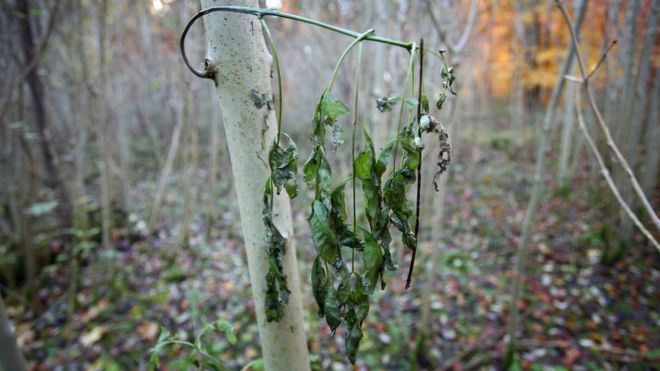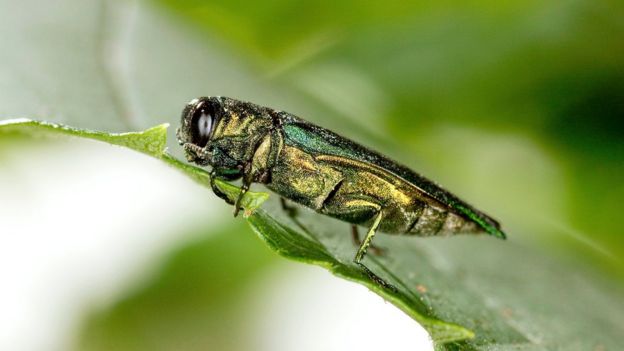白蠟樹將在歐洲滅絕 Ash tree set for extinction in Europe
白蠟樹將在歐洲滅絕 Ash tree set for extinction in Europe
根據最近大規模物種調查,白蠟樹很有可能滅絕
白蠟樹同時被一種甲蟲與傳染病危害
最近生態雜誌發表,白蠟樹是英國的樹景的重要組成部分
白蠟樹在英國各地城鎮有220萬株,但這種疾病傳染與甲蟲會使白蠟樹滅絕
很有可能會像在20世紀80年代荷蘭榆樹病讓榆樹大規模的死亡
英國的鄉村景色再也不會看起來一樣了。
這種傳染病在英國被認定在2012年發現,在樹木進口時帶入的,由真菌Hymenoscyphus
fraxineus引起,葉子受感染後,接下來樹枝,樹幹,最後整顆樹染病。
甲蟲是種亮綠色的甲蟲,原產於亞洲,成蟲取食白蠟樹,造成損傷較小。然而,幼蟲會生在
樹皮下,在樹木裡欑孔而殺死樹。
據托馬斯博士說: 甲蟲對白蠟樹的威脋,可能比傳染病更嚴重。
這不僅將改變歐洲的景觀,這將會對生物多樣性造成嚴重影響。
這將會對生物多樣性造成嚴重影響。 1000種物種和白蠟樹林有相關,包括12種鳥類,55哺乳動物和239無脊椎動物。
托馬斯先生說,“其中,有超過100種的地衣,真菌和昆蟲都依賴於白蠟樹,如果白蠟樹消失了,這些物種可能減少或跟著一起消失。
“其他的一些樹木,如榿木,小石灰闊葉樹和花楸可以為一些這些物種提供家園......但是,如果白蠟樹消失了,英國鄉村再也看起來不一樣了
一個小的希望是,一些白蠟樹已經顯示出抗病性。但是,這不會保護他們免受甲蟲侵害。
 PA
PA
The ash tree is likely to be wiped out in Europe, according to the largest-ever survey of the species.
The trees are being killed off by the fungal disease ash-dieback along with an invasive beetle called the emerald ash borer.
According to the research, published in the Journal of Ecology, the British countryside will never look the same again.
The paper says that the ash will most likely be "eliminated" in Europe.
This could mirror the way Dutch elm disease largely wiped out the elm in the 1980s.
Ash trees are a key part of the treescape of Britain. You don't have to go to the countryside to see them. In and around towns and cities there are 2.2 million. In woodland, only the oak is more common.
However, according to a review led by Dr Peter Thomas of Keele University and published in the Journal of Ecology, "between the fungal disease ash dieback and a bright green beetle called the emerald ash borer, it is likely that almost all ash trees in Europe will be wiped out - just as the elm was largely eliminated by Dutch elm disease".
Ash dieback, also known as Chalara, is a disease that was first seen in Eastern Europe in 1992. It now affects more than 2 million sq km, from Scandinavia to Italy.
 Getty Images
Getty Images
It was identified in England in 2012 in a consignment of imported infected trees. It has since spread from Norfolk and Suffolk to South Wales. Caused by the fungusHymenoscyphus fraxineus, it kills the leaves, then the branches, trunk and eventually the whole tree. It has the potential to destroy 95% of ash trees in the UK.
The emerald ash borer is a bright green beetle that, like ash dieback, is native to Asia. It's not yet in the UK but is spreading west from Moscow at a rate of 25 miles (41 km) a year and is thought to have reached Sweden.
The adult beetles feed on ash trees and cause little damage. However the larvae bore under the bark and in to the wood, killing the tree.
According to Dr Thomas: "Our European ash is very susceptible to the beetle. It is only a matter of time before it spreads across the rest of Europe - including Britain - and the beetle is set to become the biggest threat faced by ash in Europe, potentially far more serious than ash dieback."
 Science Photo Library
Science Photo Library
This won't just change our landscape - it will have a severe impact on biodiversity. 1,000 species are associated with ash or ash woodland, including 12 types of bird, 55 mammals and 239 invertebrates.
Mr Thomas said, "Of these, over 100 species of lichens, fungi and insects are dependent upon the ash tree and are likely to decline or become extinct if the ash was gone.
"Some other trees such as alder, small-leaved lime and rowan can provide homes for some of these species... but if the ash went, the British countryside would never look the same again."
One small hope is that some cloned ash trees have shown resistance against the fungus. But that won't protect them against the beetle.
0 意見:
張貼留言